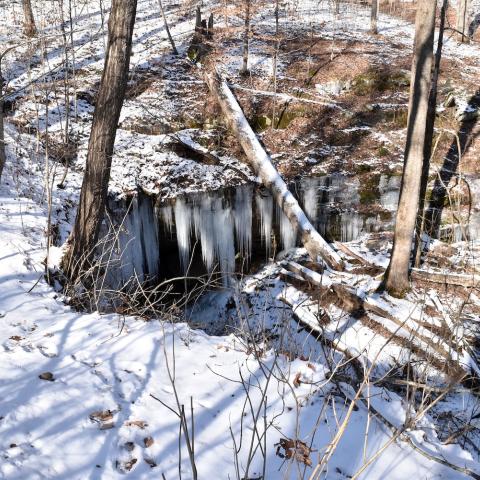
A 4 inch long male and female Clavusodens hunting for early crustaceans on the sea floor that once covered much of central Kentucky during the Middle Mississippian period, 340 million years ago/NPS Illustration, Benji Paysnoe
A new species of shark has been discovered at Mammoth Cave National Park, where fossil records have revealed more than 70 species of shark that swam in the ocean when this part of present-day Kentucky was under water about 340 million years ago.
The new species of obruchevodid petalodont, called Clavusodens mcginnisi, was identified by researchers during the ongoing Paleontological Resource Inventory through fossil teeth collected from deep inside the Ste. Genevieve Formation within Mammoth Cave.
“The fossil discoveries in Mammoth Cave continue to reveal a wealth of new information about ancient shark species,” said Superintendent Barclay Trimble. “Researchers and volunteers collected samples from the main Mammoth Cave system and from smaller isolated caves throughout the park that have provided new data on previously known ancient sharks and revealed several species that are brand new to science. These discoveries help scientists to better understand the relationship and evolution of modern shark species within this relatively small geographic region.”
Clavusodens mcginnisi, or “McGinnis’ nail tooth,” was discovered from a number of small teeth found throughout the Ste. Genevieve Formation rock layer in the national park's cave system. Its name is derived from the shark’s back teeth, which superficially look like old iron nails because of their flat crowns and long tooth bases. Nick-named “Chipmunk sharks” for their small size and chisel-like front teeth and crushing back teeth, members of the Obruchevodidae were between 3-4 inches in length. Their small size allowed them to avoid larger predators as they foraged on crustaceans, worms, and small brachiopods found along the sea floor. The species name, mcginnisi, honors retired National Park Service superintendent and naturalist David McGinnis, whose 39-year career started at Mammoth Cave National Park.
The Ste. Genevieve Formation at Mammoth Cave is a layer of rocks that date back to approximately 340 million years ago. The rocks consist of limestones and shales that formed on the bottom of a warm ocean reef. The majority of fossilized sharks are found in invertebrate hash beds, a rock layer made of skeletal and shell parts of crinoids, blastoids, corals, gastropods, and brachiopods. Prior to the discoveries made at Mammoth Cave over the last several years, no shark fossils were known from the Ste. Genevieve Formation. To date, more than 70 species of sharks and other fish have been identified from this geologic layer, including four new species.
Visit Mammoth Cave National Park PRI to learn more about the park’s ancient shark research and view images of ancient shark discoveries in the park's Shark Photo Gallery.


 Support Essential Coverage of Essential Places
Support Essential Coverage of Essential Places






